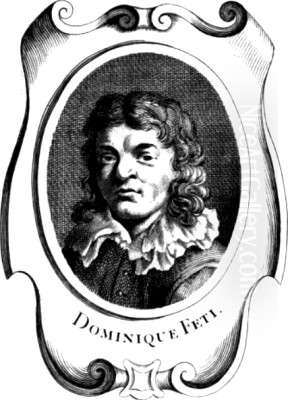
Domenico Feti stands as a significant, albeit sometimes overlooked, figure in the vibrant landscape of early Italian Baroque painting. Active during a period of profound artistic transformation, Feti forged a unique and compelling style that synthesized the diverse currents flowing through Rome, Mantua, and Venice in the early seventeenth century. Though his career was tragically cut short by his premature death, his work resonates with emotional depth, technical brilliance, and a distinctive approach to narrative, particularly evident in his celebrated interpretations of biblical parables. His journey from Rome, through the ducal court of Mantua, to the bustling artistic hub of Venice, shaped an oeuvre characterized by rich color, dramatic lighting, and profound human feeling.
Roman Foundations and Early Training
Born in Rome around 1589 or 1590, Domenico Feti emerged into an artistic environment charged with innovation and rivalry. The dominant forces were the revolutionary naturalism of Michelangelo Merisi da Caravaggio and the classicizing reforms of the Carracci family. Feti's initial training, however, was under Ludovico Cardi, known as Cigoli, a prominent Florentine painter active in Rome. Cigoli was himself a key figure in the transition from late Mannerism towards a more direct, emotionally resonant Baroque style, emphasizing clear narrative and sincere piety.
Under Cigoli's guidance, Feti would have absorbed principles of sound draughtsmanship and compositional clarity, hallmarks of the Florentine tradition. Yet, the air in Rome was thick with the influence of Caravaggio. The older master's dramatic use of chiaroscuro (strong contrasts of light and dark), his unidealized, often plebeian figures, and the raw immediacy of his religious scenes left an indelible mark on many young artists, Feti included. While Feti never fully adopted the stark, often brutal realism of Caravaggio, the latter's innovative approach to light and his focus on the human element within sacred stories clearly informed Feti's developing vision.
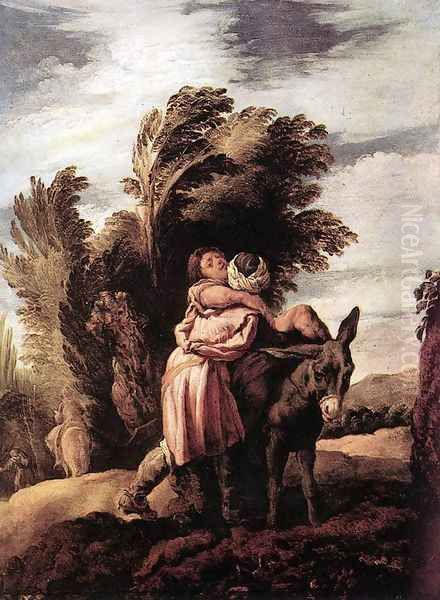
During these formative years in Rome, Feti likely also studied the works of High Renaissance masters like Raphael and Michelangelo, as well as earlier influential figures. He began to develop a sensitivity to color and texture, possibly looking towards the softer modeling and atmospheric effects found in the works of artists like Federico Barocci, whose style offered a gentle alternative to Caravaggio's intensity. This period laid the groundwork for Feti's later ability to weave together diverse stylistic threads into a coherent personal language.
Court Painter in Mantua
Around 1613 or 1614, Feti's career took a significant turn when he was appointed court painter to Cardinal Ferdinando Gonzaga in Mantua. When Ferdinando became Duke of Mantua shortly thereafter, Feti's position was solidified. The Gonzaga court had a long and illustrious history of artistic patronage, having previously employed giants like Andrea Mantegna and Giulio Romano. Though perhaps past its absolute zenith, the court still provided Feti with considerable opportunities and prestige.
His duties in Mantua were varied. He was involved in creating larger decorative works, including frescoes for the Cathedral and the Ducal Palace. Art historians generally consider these large-scale works, such as the Miracle of the Loaves and Fishes or scenes from the Life of the Virgin, to be less successful than his smaller easel paintings. They perhaps reveal a certain difficulty in translating his intimate style to monumental formats. However, his time in Mantua was crucial for his development.
The Gonzaga collections were rich in masterpieces, offering Feti continued exposure to great art. Significantly, the court had previously hosted Peter Paul Rubens. Although Rubens had left Mantua several years before Feti's arrival, his dynamic compositions, rich colors, and vigorous brushwork had made a lasting impression. It is highly probable that Feti studied Rubens's works remaining in the collection, absorbing lessons in painterly freedom and dramatic energy that would become increasingly evident in his own paintings. It was in Mantua that Feti began to concentrate on the smaller cabinet pictures, often depicting biblical scenes and parables, which would become his forte.
His relationship with Duke Ferdinando appears to have been close, fostering an environment where Feti could refine his skills and explore themes that resonated with him personally. He produced numerous works for the Duke and the court, establishing his reputation. However, his tenure in Mantua eventually ended amidst some form of dispute or disagreement, the precise nature of which remains unclear, prompting his departure for Venice around 1621 or 1622.
Venice: A Final Flourishing
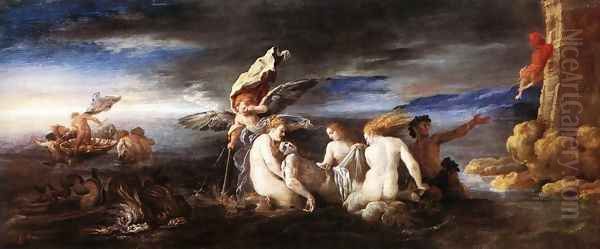
Feti's move to Venice marked the final, highly productive phase of his short life. Despite invitations from Duke Ferdinando to return to Mantua, Feti chose to remain in the Lagoon city, a center of artistic ferment with its own proud pictorial tradition. Venice offered a different artistic climate than Rome or Mantua. The legacy of the great sixteenth-century Venetian masters – Titian, Tintoretto, and Paolo Veronese – with their emphasis on color (colore) over line (disegno), atmospheric effects, and dynamic compositions, was pervasive.
In Venice, Feti's art reached its full maturity. He seemed to thrive in this environment, fully integrating the lessons of Venetian color and light with his Roman training and the dramatic impulses derived from Caravaggio and Rubens. He largely abandoned large-scale commissions and focused almost exclusively on producing smaller, intensely felt easel paintings. These works, often executed on wood panel, were highly sought after by Venetian collectors and patrons for their private galleries (quadrerie).
His specialization in depicting the parables of the New Testament became his most distinctive contribution during this period. Works like The Good Samaritan, The Parable of the Sower, The Parable of the Lost Coin, and The Parable of the Pearl of Great Price showcase his ability to translate biblical allegory into vivid, relatable human drama. He often set these scenes in contemporary-looking landscapes or interiors, using expressive figures and rich, atmospheric lighting to convey the moral and spiritual weight of the stories. His brushwork became looser and more painterly, his colors richer and more nuanced, reflecting the Venetian milieu.
He quickly gained recognition in Venice, influencing local artists and becoming a notable figure in the city's artistic life. His workshop was active, although details about its specific operations remain limited. Tragically, this period of intense creativity and success was brief. Domenico Feti died in Venice in 1623, likely only around 34 years old. His death cut short a career that was still ascending, leaving behind a body of work remarkable for its quality and originality achieved in less than two decades.
Artistic Style: A Synthesis of Influences
Domenico Feti's style is compelling precisely because it represents a masterful synthesis of the major artistic currents of his time. He did not simply imitate; he absorbed, transformed, and integrated diverse elements into a unique and personal vision. His art stands as a bridge between the structured naturalism of Rome, the courtly elegance of Mantua, and the painterly richness of Venice.
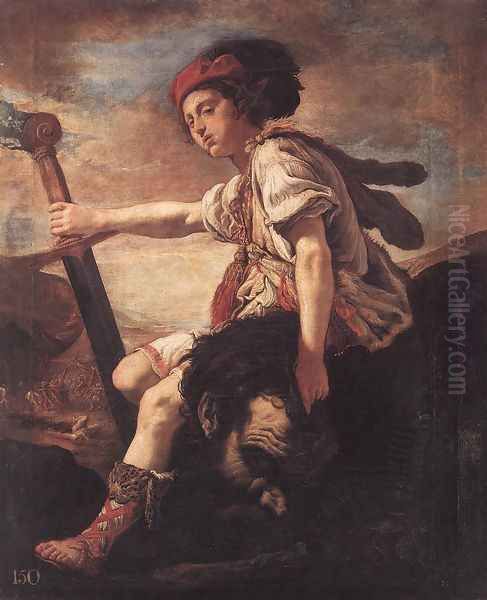
Light and Shadow: Feti employed chiaroscuro with great skill, but his approach often differed from the stark drama of Caravaggio. While capable of strong contrasts, Feti frequently used light in a softer, more atmospheric way. Light seems to emanate from within his scenes, modeling figures gently and creating a palpable mood, often one of quiet contemplation or spiritual intensity. His shadows are rich and deep, but rarely impenetrable, allowing details to emerge subtly. This nuanced handling of light contributes significantly to the emotional resonance of his work.
Color and Brushwork: Having absorbed the lessons of Cigoli and Rome, Feti fully embraced the Venetian emphasis on color during his final years. His palette could range from earthy, somber tones, appropriate for penitential or melancholic themes, to passages of jewel-like brilliance and warmth, particularly in fabrics and highlights. His brushwork evolved towards a more painterly style, especially in Venice. Strokes are often visible, applied with a certain freedom and texture (impasto), giving his surfaces a vibrant, tactile quality. This technique enhances the sense of immediacy and the play of light across forms.
Themes and Subjects: While capable of mythological scenes, such as Hero and Leander, and allegories like the famous Melancholy, Feti is best known for his religious subjects. He showed a particular affinity for the parables of Christ, interpreting them not as grand historical events but as intimate human dramas imbued with spiritual significance. He brought these stories to life with a sense of psychological insight, exploring themes of mercy, repentance, labor, and divine grace. His figures, often depicted as common people, convey genuine emotion, making the sacred narratives accessible and relatable.
Influences: Feti's artistic DNA included strands from many sources. His grounding came from Cigoli. The impact of Caravaggio's realism and light is undeniable. The soft sfumato and emotional grace of Correggio, and the gentle piety of Federico Barocci, seem to echo in his more tender scenes. The compositional energy and rich palette of the Venetians, particularly Veronese and Tintoretto, informed his later work. The dynamism and painterly bravura of Rubens were clearly assimilated, especially after his Mantuan experience. Furthermore, the influence of the German artist Adam Elsheimer, known for his small, meticulously detailed paintings on copper with innovative light effects, is often cited as crucial for Feti's development of the cabinet picture format.
Masterpieces and Key Works
Though his oeuvre is not vast compared to longer-lived contemporaries, Feti produced several works that are considered masterpieces of the early Baroque period. His series of New Testament parables stands out as his most characteristic and influential achievement.
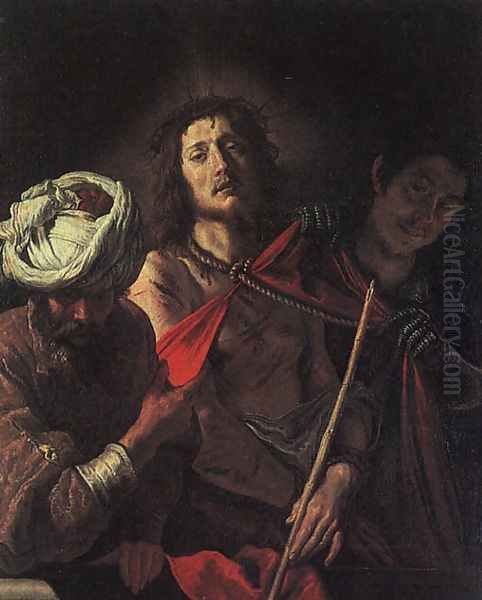
The Parables Series: Executed primarily during his Venetian period, these small-scale paintings (often on panel) represent the pinnacle of Feti's art. Works like The Good Samaritan (versions in Metropolitan Museum of Art, NY; Dresden), The Parable of the Lost Coin (Dresden), The Parable of the Workers in the Vineyard (Dresden), The Parable of the Sower (Prague), The Parable of the Pearl of Great Price (Kunsthistorisches Museum, Vienna), and The Parable of the Unforgiving Servant (Dresden) exemplify his approach. He typically uses contemporary settings and costumes, focusing on the human interactions and emotional core of the story. The brushwork is often fluid and expressive, the lighting atmospheric, drawing the viewer into the scene's moral and spiritual drama. These works combine genre observation with profound religious feeling.
David with the Head of Goliath: (c. 1617-1619, Gemäldegalerie Alte Meister, Dresden) This powerful image showcases Feti's engagement with the Caravaggesque tradition. The dramatic lighting focuses intensely on the young hero and the gruesome trophy, emphasizing the psychological weight of the moment rather than just the violence. David's expression is complex – a mixture of triumph, exhaustion, and perhaps contemplation. The rich handling of textures, from the metallic sheen of armor to the rough hair of Goliath, demonstrates Feti's technical skill.
Melancholy (La Malinconia): (c. 1620, versions in the Louvre, Paris; Accademia, Venice) This allegorical subject was popular in the Renaissance and Baroque periods. Feti's interpretation is deeply atmospheric and introspective. The figure, often depicted slumped amidst symbols of learning and the arts, is bathed in a soft, internal light against a dark background. The painting evokes a mood of quiet contemplation and perhaps the burden of creative thought, rendered with Feti's characteristic sensitivity to light and texture.
Ecce Homo: (Versions exist, e.g., Alte Pinakothek, Munich) Feti treated this theme of Christ presented to the crowd multiple times. His depictions focus on the suffering and dignity of Christ, often using close-up compositions and dramatic lighting to enhance the emotional impact. The rendering of flesh and fabric is typically rich and tactile, inviting empathetic engagement from the viewer.
Other Notable Works: Paintings like The Flight into Egypt and Jacob's Dream demonstrate his ability to integrate figures into evocative landscapes, often nocturnal scenes where his handling of light creates a sense of mystery and wonder, possibly reflecting the influence of Adam Elsheimer. His Vanity (related to Melancholy) explores moralizing themes through allegory.
Influence and Legacy
Despite the brevity of his career, Domenico Feti exerted a noticeable influence, particularly on painting in Venice during the 1620s and beyond. His arrival injected a new vitality, blending Roman structure with a fresh take on Venetian painterliness and Caravaggesque drama.
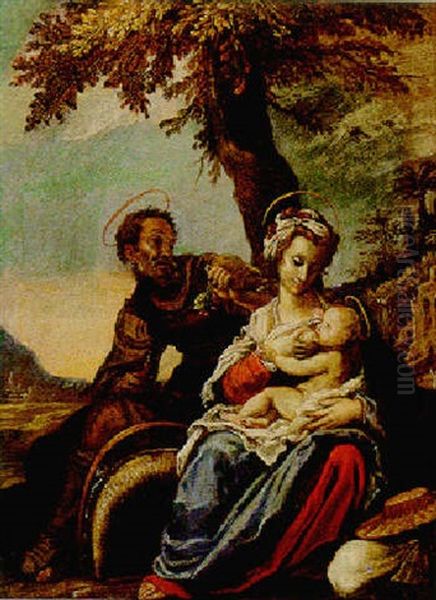
Several artists active in Venice clearly responded to his style. Pietro Muttoni, called Pietro della Vecchia, known for his often eccentric genre scenes and pastiches of earlier masters, absorbed elements of Feti's dramatic lighting and character types. Sebastiano Mazzoni, another highly individualistic Venetian painter, shows affinities with Feti's fluid brushwork and imaginative compositions. Perhaps most significantly, the German painter Johann Liss, who arrived in Venice around the same time as Feti, shared a similar painterly dynamism and interest in dramatic light and color, suggesting mutual awareness or influence. The Genoese painter Bernardo Strozzi, also active in Venice, worked in a similarly robust and colorful Baroque idiom. Later Venetian artists like Francesco Maffei also seem to carry echoes of Feti's expressive energy.
Feti's works were highly prized by collectors soon after his death and entered prestigious European collections, notably in Dresden, Vienna, Paris, and Florence. His specialization in cabinet-sized pictures catered to a growing market for smaller, privately owned artworks. However, his fame perhaps suffered somewhat due to his short life and the subsequent dominance of later Baroque masters. At times, his works were misattributed, sometimes even to Rembrandt, a testament perhaps to his quality and his mastery of evocative lighting, though their styles are fundamentally different.
In modern art history, Feti is recognized as a crucial transitional figure. He successfully navigated the complex artistic landscape of early seventeenth-century Italy, creating a style that was both synthetic and deeply personal. He excelled in translating grand religious themes into intimate, psychologically resonant narratives, particularly through his innovative interpretations of the parables. His work stands as a testament to the rich cross-currents of the Baroque era and the enduring power of painting to convey profound human and spiritual truths.
Conclusion
Domenico Feti's life may have been short, but his artistic legacy is significant. As a painter who moved between the key artistic centers of Rome, Mantua, and Venice, he became a conduit for diverse stylistic ideas, forging them into a unique and expressive language. His mastery of light and shadow, his rich sense of color, his fluid brushwork, and his profound engagement with religious narrative, especially the parables, mark him as a standout talent of the early Italian Baroque. Though overshadowed at times by contemporaries with longer careers, Feti's paintings continue to captivate viewers with their emotional depth, technical brilliance, and the luminous, often poignant, world they depict. He remains an essential figure for understanding the vibrant evolution of painting in seventeenth-century Italy.